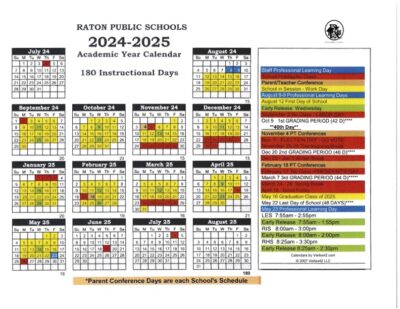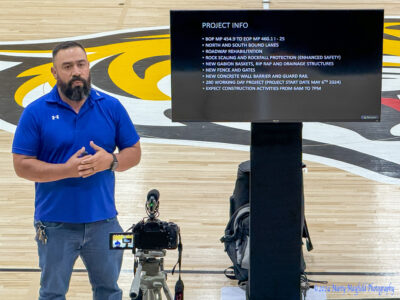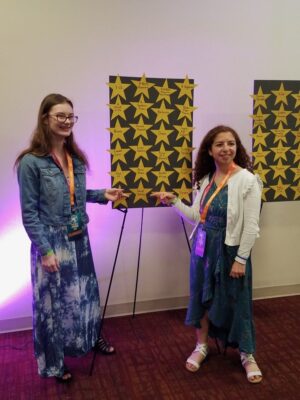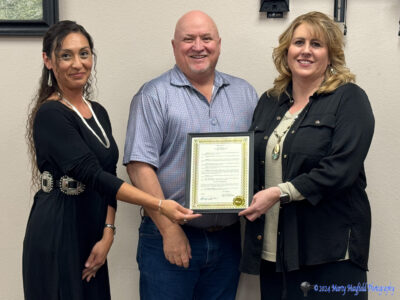By Dave Kavanaugh and Jesse Gallegos
Luna Community College
Luna Community College is poised to move forward with a renewed commitment to serving the educational and workforce training needs of northeastern New Mexico after receiving news that it is once again accredited free of sanctions.
The Higher Learning Commission has notified Luna’s administration that its probationary status has been removed after demonstrating full compliance with all requirements for accreditation. The decision came as part of the HLC Board of Trustees’ regular November meeting.
“I want to thank Luna students, faculty, staff, administrators, board of trustees and community members for their assistance throughout this process,” said interim President Dr. Kenneth Patterson. “We look forward to making Luna Community College one of the premier colleges in the Southwest. Luna has played such an important role for so many students over the last 50-plus years, and we hope to have an even greater impact over the next 50 years.”
”On behalf of the NMICC colleges that we are just thrilled that Luna is moving on to a new chapter,” said NMICC Director Kathy Ulibarri. “We’re so pleased that Luna has achieved full accreditation status and we look forward to Luna being a full-fledged member of New Mexico’s higher education community for years to come.
Luna had operated under HLC sanctions since November 2017, when the Chicago-based regional accrediting agency issued a show-cause order.
In a summary of the action taken by the HLC, the (HLC) Board determined that the Institution is no longer out of compliance with the criteria for accreditation, removing the institution from probation and assigning interim monitoring. The institution meets Core Components 5.A, 5.C, and 5.D with concerns. The institution is required to host a Focused Site Visit no later than February 2022 to demonstrate ongoing progress in regards to financial viability and institutional planning.
The college’s initial response to the show-cause order, accompanied by an outpouring of testimonials in a fervent #LCCMatters campaign, resulted in the HLC lifting the order and placing Luna on probation starting in June 2018.
The college continued efforts to address the areas of deficiency raised in the original show-cause order and probation and hosted an HLC site-visit team in the spring of 2019. In conjunction with the visit, various members of the campus community collaborated on a comprehensive report that tackled not only the areas found not to be in compliance but other accreditation criteria.
On the heels of that visit and subsequent testimony by a Luna delegation in Chicago, the HLC Institutional Actions Council found that Luna had made some significant progress in most areas, meeting requirements in 18 of 21 core component areas. But the HLC Board of Trustees voted to keep Luna on probation, allowing the college more time and opportunity to improve its performance in some regards and to demonstrate continued improvement in others.
In the past year, Luna prepared for a Focused Site Visit from another HLC team of reviewers. The college prepared a report that updated reviewers on ongoing work to meet the areas of concern.
Areas of deficiency as determined by the HLC were specific components from Criterion Two, Integrity, Ethical & Responsible Conduct, and Criterion Five, Resources, Planning & Institutional Effectiveness.
The HLC had previously determined that Luna meets or exceeds standards in the entirety of Criterion One, Mission; Criterion Three, Teaching & Learning, Quality, Resources & Support; and Criterion Four, Teaching & Learning, Evaluation & Improvement.
Luna’s HLC report-writing team compiled evidence to show the college is now fully compliant in components 2A, 5A and 5B and an assumed practice D3 related to participation in College Scorecard.
Due to the COVID-19 pandemic, the Focused Site Visit was conducted with two of three reviewers participating remotely this past Sept. 10-11. The reviewers’ ensuing report was then submitted to the HLC Board of Trustees for consideration.
The HLC’s review
The HLC wrote: The institution now meets Criterion Two, Core Component 2.A, “the institution operates with integrity in its financial, academic, personnel, and auxiliary functions; it establishes and follows policies and processes for fair and ethical behavior on the part of its governing board, administration, faculty, and staff,” for the following reasons:
- Board integrity is demonstrated in new policies that prevent nepotism and support ethical behavior.
- The board is receiving appropriate levels of training, which include training on the Open Meetings Act, budgeting, governance, ethical behavior, and fiduciary responsibility.
- Board interaction with staff and faculty is guided through the Institution’s President. Communication between the president and the chair of the board takes the form of weekly written updates.
- Board agenda items are established through meetings with the president and board chair.
The institution now meets, but with concerns, Criterion Five, Core Component 5.A, “the institution’s resource base supports its current educational programs and its plans for maintaining and strengthening their quality in the future for the following reasons:
- The institution is economically dependent on financial resources flowing from federal and state appropriations and local property taxes. The current economic model reflects the following primary revenue streams: state appropriations funding and local property taxes, which comprise over 80 percent of the total operating revenue. In comparison, tuition and fees account for less than 10 percent of the operating revenues. Both the state funding and tuition revenue are sensitive to enrollment, which has significantly declined, resulting in operating deficits and limited availability of resources. The institution also stated that the population in its service area is shrinking, which could negatively affect the level of resources generated by operations.
- Enrollment reports showed a drop from 777 full-time student equivalents in the fiscal year 2014-15 to 565 full-time student equivalents in the fiscal year 2018-19. Furthermore, the institution reported that the headcount for fall 2020 equaled 712 students, down 31.7 percent from the fall 2019 headcount of 1,042 students. Since student enrollment has been declining, the fallout indicates there is more capacity than student demand. Although the results were not available, the administration believes a portion of the tuition revenue loss may be offset by the newly developed workforce training programs, dual credit offerings, and implementation of 8-week sessions.
Although enrollment is expected to remain flat, the administration recommended, and the Board approved, a 6 percent per year tuition rate increase, including in-district and out-of-district and -state for fiscal years 2021 through 2024. Additionally, the Board approved revising the fee structure for credit and non-credit students. The five-year forecast model indicates an infusion of $147,000 from the increase in tuition and fees starting in fiscal year 2021. The action may be justified but is counter to the deflationary tuition market that postsecondary education is experiencing.
The Long-Term Sustainability Planning Guide focuses on three principles:institutional plans, program review, and annual department plans. The Planning Guide mentions the establishment of key financial indicators that will assist in guiding the Institution to financial solvency, which includes financial indicators, scoreboard indicators, and academic program efficiency reviews. The Planning Guide also discloses retention and graduation rates for fiscal years 2014-15 through fiscal years 2018-19 and indicates “the need to review and revise strategies thereof.” However, no situational assessments or improvement strategies are offered to improve student outcomes. The Planning Guide’s forecast based on the performance indicators used projected operating deficits through fiscal year 2022-23.
Luna’s Institutional Focused Visit Report stated that the “Board of Trustees has been tasked with adopting a series of financial policies that provide the guiding framework for the college’s financial practices and desired financial outcomes.” However, HLC’s Board did not find specific evidence that would support recommended best practices.
The Institution undergoes an annual financial audit, which includes a review of the system of internal controls. The fiscal year 2019-20 annual audited financial report received an unmodified opinion from the auditors indicating a fair presentation of the financial statements in all material respects. • The fiscal year 2019-20 audited financial report reported operating revenue of $4.0 million, operating expenses of $18.2 million, and non-operating revenue of $10.0 million for a financial imbalance or change in net position of $4.2 million. Additionally, the Institution’s total net position of $1.0 million is separated as net investment in capital assets of $22.5 million and unrestricted equity of minus $21.5 million, resulting from several years of deficit results. The operations provided a net increase in cash and cash equivalents of $375,000. This was primarily the result of noncapital financing activities (state appropriations and local property taxes) of $9.8 million, exceeding the amount of net cash used by the operations of $9.2 million. • Luna has deferred specific building maintenance and related systems upkeep from a normal operating budget cycle due to the lack of funds. The Facilities Master Plan for the fiscal year 2019-20 reported that deferred maintenance was estimated to be $10.2 million. • The institution is well aware of the trends and challenges it faces. The relatively new administration has aggressively assessed the Institution’s present situation and is applying an integrated approach to develop several new or revised plans for a sustainable economic model that will balance the operations for financial viability. Also, the board’s oversight is apparent. However, the demonstration of progress will be time-sensitive. The institution is in the midst of various planning and implementation stages, and it is too early to assess the results. During the transformation, Luna will also need to bridge the resource gap, which is the difference between its current financial position and a prosperous future (also see comments under Criterion 5, Core Component 5.C.).
The institution now meets Criterion Five, Core Component 5.B, “the institution’s governance and administrative structures promote effective leadership and support collaborative processes that enable the institution to fulfill its mission,” for the following reasons:
- The institution’s establishment of policies and procedures provides a sustainable framework for assuring shared governance. Specifically, Board Policy 1520 as amended clarifies the relationship between the Board of Trustees and the institution’s shared governance structure. It also creates clear expectations of the roles of the Board of Trustees, the institution’s president, the faculty and staff shared governance structure, and other institutional constituents.
- During a six-week time period, twenty different institutional issues, practices, procedures, and policies were documented and discussed, resulting in what is expected to be a highly productive shared governance system.
The institution now meets the Federal Compliance Requirement related to Review of Student Outcome Data for the following reasons:
- While acknowledging that its use of the U.S. Department of Education (USDE) College Scorecard is still in its infancy, Luna has oriented faculty and staff to the Scorecard and its uses and the Scorecard is readily available on the Luna website.
- Luna uses the information contained in the Scorecard in various ways, including, but not limited to, affordability comparisons within New Mexico and competitive tuition analyses.
- Academic departments are beginning to use Scorecard information in annual and strategic budgeting exercises. Specifically, Luna now requires that all academic departments submit Scorecard information not only when developing budgets but also in Academic Department Annual Reports.
- The Institution has also made Scorecard information readily available to students to assist in making comparisons among Luna and other institutions.
- Luna is participating more fully in the USDE College Scorecard program and is meeting its obligations.
The HLC Board is requiring that the institution host a focused visit regarding Core Components 5.A, 5.C, and 5.D3 no later than February 2022, with specific focus on the following:
- With regard to finances: The institution must demonstrate its use of evidence to verify that the new economic model is leading toward long-term financial sustainability. Evidence is needed of robust assessments of progress that will allow for continuous improvement and lead to reinvestment in student success, new and existing program development, technology, marketing, and employee professional development.
- With regard to planning: The institution must demonstrate sustained attention to planning and the integration of its planning activities in support of achieving its outcomes, particularly in support of its enrollment and financial sustainability goals.
- With regard to institutional effectiveness: The institution must demonstrate that its use of evidence to inform performance has remained consistent and is maturing to support its planning activities and financial performance.
Moving forward
Luna has been placed on the HLC Standard Pathway, with its next comprehensive evaluation for reaffirmation of accreditation in 2024-25.
“We want to thank the Higher Learning Commission for helping make us a better college,” Patterson said. “Because of the HLC and the standards established, our college has a better foundation. This process will have the net result of making us stronger as we pursue our No. 1 goal – continuing to create opportunities for our students and communities.”
The Higher Learning Commission accredits approximately 1,000 colleges and universities that have a home base in one of 19 states that stretch from West Virginia to Arizona. HLC is a private, non-profit accrediting agency. It is recognized by the U.S. Department of Education and the Council for Higher Education Accreditation
Luna has been accredited by the HLC since 1982. The college offers approximately three dozen certificate and associate degree programs in seven departments – Allied Health Sciences, Business, Career and Technical Education, Early Childhood Education, Humanities, Nursing and STEM.
###






Great job. Las Vegas comes together again.